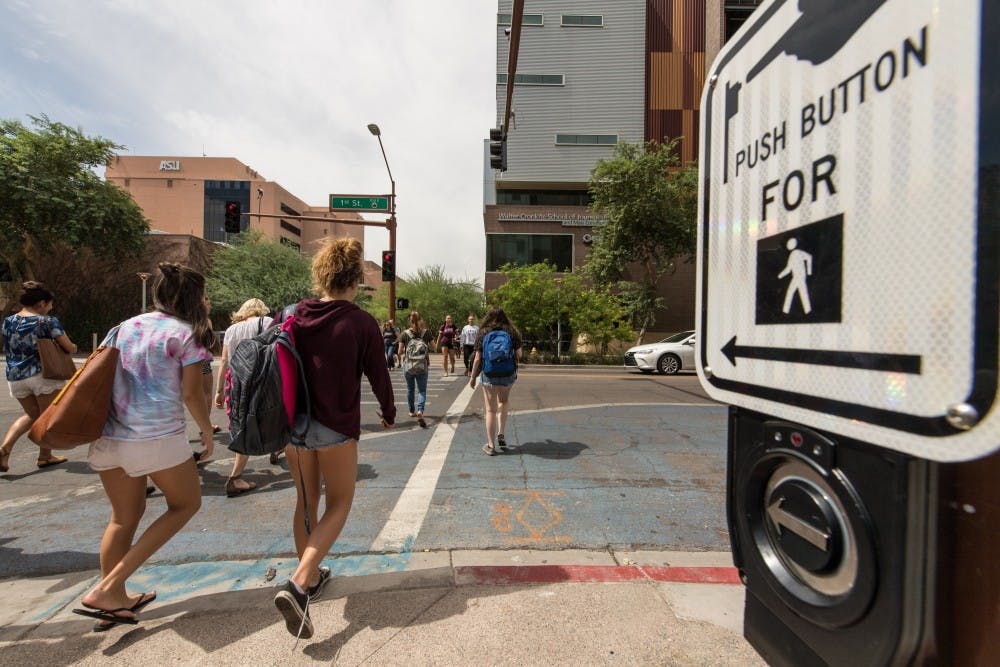Downtown Phoenix is full of hundreds of people throughout the day, crossing streets and maneuvering alongside cars, but social work junior Joey Hagemeier doesn’t see the hustle of city life. He can’t see anything but light and shadow.
Hagemeier is one of approximately 450 students studying at ASU's Downtown Phoenix campus with some form of disability that affects their learning. These students face additional difficulty in their everyday lives, including getting to and from their destinations.
“I nearly got hit by a car a few weeks ago,” said Hagemeier. “People (were) stopping in crosswalks to have conversations, and I wasted like five valuable seconds trying to get around them.”
Most crosswalks near the Downtown Phoenix campus, where Hagemeier lives, only have somewhere between10 and 15 seconds for somebody to cross, seconds which he considers precious.
"All I see is lights and shadows," he said. "I understand, you see your best friend and you want to say hello, but can you at least get on the sidewalk first."
Change needs to happen, Hagemeier said, before somebody is hurt.
“It sounds like elementary school, but I think we need a crossing guard,” said Hagemeier. “It puts the whole campus at risk. You can’t always depend on that tech to always work. How do I know one day it's not inaccurate?”
This issue, faced by Hagemeier and other students with visible disabilities, is something that the Disability Resource Center addresses on a case-by-case basis said Alicia Wackerly-Painter, Downtown Phoenix campus Disability Resource Center assistant director.
“Given the urban environment and given the foot traffic, ... it could be a number of variables,” she said. “Anytime a student brings to us a safety concern, we always address it with the student directly.”
Wackerly-Painter added that several accommodations could be made to minimize the safety issue, including a police escort or better education for the general student population.
“We partner with ASU PD and with the City of Phoenix. We have plenty of partners in the city to ensure that safety concerns are addressed,” she said, adding that she was unaware of any current safety concerns being worked on by the DRC.
One other option Wackerly-Painter suggested was to work with city officials to change the light patterns at some crosswalks throughout the downtown area.
“(There are) ways we can address it if we know it’s happening,” she said. “It’s not out of the ordinary for us to look into something like that.”
As for what lights to change, that would depend on the needs of the student and could require new infrastructure to be built by the city.
Only about 25 percent of the streetlights in downtown Phoenix have audible pedestrian push buttons, otherwise known as APS buttons, said Monica Hernandez, City of Phoenix spokesperson. These buttons make a sound when it's okay for pedestrians to cross and help people like Hagemeier to cross safely.
However, she said, bringing the APS buttons to the other 75 percent of the traffic signals in the area could take time as there are currently over 100 traffic signals total in downtown Phoenix.
“There are no specific evaluations (of what sites need the APS buttons),” Hernandez said. “Any we install will meet current placement requirements. If we get specific requests we will address them, otherwise will address during intersection rebuilds or as part of other construction projects.”
However, if changes are requested to accommodate students or pedestrians, the priority would shift to those lights.
“Individual requests to have APS buttons installed are addressed as received,” Hernandez said. “We are working to ultimately have them at every intersection.”
Correction: A previous version of this article said that there were currently over 1,100 traffic signals in downtown Phoenix. There are over 100 traffic signals in downtown Phoenix.
Reach the reporter at ckmccror@asu.edu or follow @ckm_news on Twitter.
Like The State Press on Facebook and follow @statepress on Twitter.




